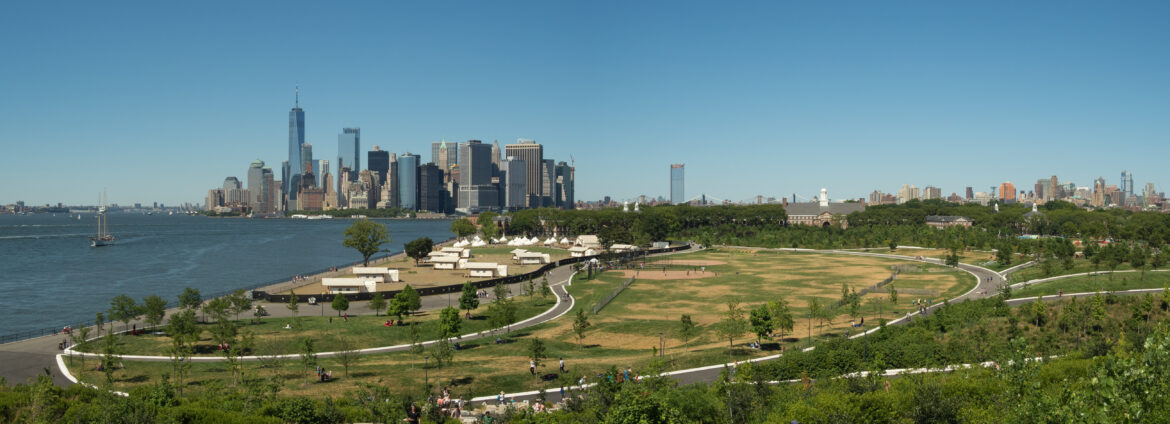Above: Photo by Rhododendrites/Wikimedia Commons
In April 2023, Stony Brook University (SBU) was named the anchor institution for the New York Climate Exchange — The Exchange. Located on Governor’s Island in New York City, The Exchange will be a “first-of-its-kind” international center geared towards researching and developing solutions to urban climate issues, as well as furthering work, education and training opportunities in the environmental field for New Yorkers. SBU is the anchor institution, which means that most of the research will be conducted in collaboration with it and that it will most likely have more authority and leadership in The Exchange’s decision making.
The Exchange’s website states that the project is committed to environmental justice by improving “discriminatory practices of the past” and acknowledges the damage that climate change does specifically to “low-income communities and communities of color.” However, none of the partner coalitions and social organizations under The Exchange have been identified as Indigenous or Indigenous-affiliated.
Because of the strong conservation efforts promoted by Indigenous communities, many have called for a “braiding” of science with Indigenous knowledge to foster advancements in the fields of environmental science and ecology. Through the inclusion of Indigenous knowledge in these areas, there is hope that conservation efforts will be stronger and more on par with scientific developments.
Indigenous communities have demonstrated resilience and adaptation in the face of climate change. Embedded in Indigenous communities’ cultural practices is the observation and protection of their land due to the deep spiritual connections they have with the environments they inhabit. As a result, they hold a vast amount of knowledge and experience with the lands they occupy.
Yet, Indigenous communities are often more vulnerable to the health impacts of climate change than the general population. These communities are also more likely to suffer from poverty, creating the perfect storm for them to be highly subjected to the negative consequences of climate change.
Climate change causes fluctuating temperatures, rising sea levels and ocean acidification. Because of these, Indigenous communities have not only lost territory, but have also experienced smaller harvests and lowered produce quality. This leaves them with no choice but to combat these issues as they continue to disrupt and threaten the Indigenous way of life.
“In our research, we find that changes in temperature and temperature variability are associated with changes in the risk of mortality, cardiovascular disease, and respiratory disease,” said Mahdieh Danesh Yazdi, assistant professor in the public health program at the Stony Brook School of Medicine. Yazdi researches the effects of air pollution and climate change on human health and epigenetics — how DNA can be altered through your environment and behaviors.
Long Island has no shortage of Indigenous peoples — 14 Indigenous communities have lived or continue to live on the Island. One community that has taken matters into their own hands is the Shinnecock Nation — also known as “people of the shore” — who reside in Southampton, just 40 miles away from Stony Brook University’s main campus. Shinnecock kelp farmers are addressing the ocean acidification happening right in front of their homes.
As a “playground for the rich and famous,” the Hamptons was wealthy New Yorkers’ prime escape in 2020 due to the COVID-19 pandemic. The region’s crumbling water sanitation infrastructure hit a “breaking point” and couldn’t keep up with the large influx of people. This breaking point caused leakage and spills of excess nitrogen, which entered the surrounding bodies of water. Excess nitrogen in waterways can cause overgrowth of algae and other aquatic plants, leading them to suck up the oxygen in the water and block sunlight from reaching other organisms. This acidifies the water, leaving it undrinkable and uninhabitable for marine life.
The Shinnecock community, whose members rely on this water, started planting kelp to help mitigate the effects of pollution, rapid development and climate change on their water. Kelp, a large brown species of seaweed, has proven to be effective in mitigating ocean acidification. Since they started growing and planting kelp, there has been an increase in the populations of scallops, clams, sea horses and other species.
“Given the importance of the marine ecosystem to many communities economically, socially, and culturally, harm to the ecosystem may also result in adverse mental health outcomes,” Yazdi said.
Shavonne Smith, environmental director of the Shinnecock Nation, added to this idea when she spoke to Agence France-Presse: “If you’re talking about taking a people that are so dependent on the water – for spiritual health, recreational and sustenance – and now moving them further inland, you’re talking about a very huge, stressful, emotional, dynamic shift in who we are,”
Kelsey Leonard — the Canada research chair in Indigenous waters, climate and sustainability at the University of Waterloo and a citizen of the Shinnecock Nation — thinks that the meaning of Shinnecock, “people of the shore,” is prophetic.
“I think our ancestors had a vision in calling us that, that we had a duty and a responsibility to care for that shore,” she said. “What you see us doing today … is in fact a key pillar of how we see ourselves living up to our responsibilities as Shinnecock people. It’s inherent and innate to who we are.”
The Shinnecock Nation is one of the many Indigenous communities preserving the land they reside on, as well as reversing the damage incurred from climate change. The preservation and conservation efforts put forth by Indigenous communities far supersedes those of non-Indigenous communities. A 2019 report compiled by the Intergovernmental Science-Policy Platform on Biodiversity and Ecosystem Services demonstrated that 75% of the terrestrial environment and about 66% of the marine environment have been “significantly altered” by human activity. However, this damage has been less severe in areas held or managed by Indigenous communities. The report further recommended environmental initiatives make an “explicit consideration of the views, perspectives and rights of Indigenous Peoples and Local Communities.” In addition, according to a study published in Nature, “territories of the world’s 370 million Indigenous peoples cover only 24% of land worldwide, but contain 80% of the world’s biodiversity.”
Indigenous communities have demonstrated their ability to adapt to and resist climate change with low-cost, effective solutions. This provides the opportunity for institutions to work with these communities to enhance these ideas, and make them effective on a larger scale. The Exchange has a unique opportunity to collaborate with their next-door neighbors, and create revolutionary climate change solutions. The gap between scientists and Indigenous communities needs to be narrowed – and The Exchange can do it.
“I think it behooves organizations and entities like the New York Climate Exchange to include Indigenous peoples because that is now the status quo,” Leonard said. “Not doing so is sort of putting you behind the eight-ball. You’re not operating off of the best available science to make informed decisions … you’re operating at a deficit.”
The lack of Indigenous knowledge as part of The Exchange is ironic considering that SBU’s main campus resides on the land of the Setauket tribe, who were forcibly displaced. A land acknowledgment message sits at the bottom of the university’s website, stating that the university affirms “[I]ndigenous sovereignty, history, and experience.” However, when it comes to climate justice, Indigenous voices are cast aside.




Comments are closed.